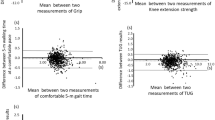Summary
Day-to-day variability and single-measurement reliability of selected isokinetic knee extension-flexion strength and endurance indices were assessed in 10 adult men and 8 adult women. On three occasions separated by at least 5 days, the subjects completed 4 reciprocal maximal voluntary contractions (MVC) at different angular velocities (1.05 rad · s−1 and 3.14 rad · s−1). The men also completed a muscular endurance test consisting of 30 reciprocal, MVC at 3.14 rad ·−1. Coefficient of variation, intra-class correlation coefficient and standard error of single-measurement scores support the continued use of gravity corrected peak torque (PT) and average peak torque (APT) as indices of isokinetic leg strength. Similarly, gravity corrected APT and total work should be the recommended indices of isokinetic leg muscular endurance in men. The results suggest that these isokinetic indices must be assessed using multiple day-to-day trial protocols adequately to describe performance capacity. Composite indices such as the ratio of Knee flexion to extension PT and fatigue measurements offer considerably reduced reliability and a greater potential for misinterpretation. The reliability of knee extension indices generally exceeds that of flexion indices. Similar variability and reproducibility of responses were observed between men and women and between reciprocal contractions performed at angular velocities of 1.05 rad · s−1 and 3.14 rad · s−1.
Similar content being viewed by others
References
Baltzopoulos V, Brodie DA (1989) Isokinetic dynamometry: applications and limitations. Sports Med 8:101–116
Bohannon RW, Smith MB (1989) Intrasession reliability of angle specific knee extension torque measurements with gravity corrections. J Ortho Sports Phys Ther 11:155–157
Burdett RG, Swearingen J van (1987) Reliability of isokinetic muscle endurance tests. J Ortho Sports Phys Ther 8:485–489
Burke EJ, Wojcieszak I, Puchow M, Michael ED (1985) Analysis of high intensity bicycle tests of varying duration. Exerc Physiol 1:159–170
Burnie J, Brodie DA (1986) Isokinetic measurement in preadolescent males. Int J Sports Med 7:205–209
Currier DP (1984) Elements of research in physical therapy, 2nd edn. Williams and Wilkins, Baltimore
Enoka RM (1988) Neuromechanical basis of kinesiology. Human Kinetics, Champaign, Ill., pp 155–160
Feiring DC, Ellenbecker TS, Derscheid GL (1990) Test-retest reliability of the Biodex isokinetic dynamometer. J Ortho Sports Phys Ther 11:298–300
Francis K, Hoobler T (1987) Comparison of peak torque values of the knee flexor and extensor muscle groups using the Cybex II and Lido 2.0 isokinetic dynamometers. J Orthop Sports Phys Ther 8:480–483
Gleeson NP, Mercer TH (1991) Intra-subject variability in isokinetic knee extension and flexion strength characteristics of adult males: a comparative examination of gravity corrected and uncorrected data. J Sports Sci 4:415–416
Harries UJ, Bassey EJ (1990) Torque-velocity relationships for the knee extensors in women in their 3rd and 7th decades. Eur J Appl Physiol 60:187–190
Hislop HJ, Perrine JJ (1967) The isokinetic concept of exercise. Phys Ther 47:114–117
Johnson J, Siegel D (1978) Reliability of an isokinetic movement of the knee extensors. Res Q 49:88–90
Kannus P (1988) Ratio of hamstring to quadriceps femoris muscles' strength in anterior cruciate ligament in sufficiency knee. Relationship to long term recovery. Phys Ther 68:961–965
Kannus P, Jarvinen M (1989) Prediction of torque acceleration energy and power of thigh muscles from peak torque. Med Sci Sports Exerc 21:304–307
Knapik JJ, Marcos U, Ramos MD (1980) Isokinetic and Isometric torque relationships in the human body. Arch Phys Med Rehabil 61:64–67
Mathiassen SE (1989) Influence of angular velocity and movement frequency on development of fatigue in repeated isokinetic knee extensions. Eur J Appl Physiol 59:80–88
Milner-Brown HS, Stein RB, Lee RG (1975) Synchronisation of human motor units: possible roles of exercise and supra-spinal reflexes. Electroencephalogr Clin Neurophysiol 38:245–254
Montgomery LC, Douglass LW, Deuster PA (1989) Reliability of an isokinetic test of muscle strength and endurance. J Ortho Sports Ther 10:315–322
Narici MV, Sirtori MD, Mastore S, Mognoni P (1991) The effect of range of motion and isometric pre-activation on isokinetic torques. Eur J Appl Physiol 62:216–220
Perrin DH (1986) Reliability of isokinetic measures. Athletic Training 21:319–321, 394
Perrin DH, Robertson RJ, Ray RL (1987) Bilateral isokinetic peak torque, torque acceleration energy, power, and work relationship in athletes and nonathletes. J Ortho Sports Phys Ther 9:184–189
Rochcongar P, Morvan R, Dassonville JJ, Beillot J (1988) Isokinetic investigation of knee extensors and knee flexors in young French soccer players. Int J Sports Med 9:448–450
Rothstein JM, Delitto A, Sinacore DR, Rose SJ (1983) Electromyographic, peak torque, and power relationships during isokinetic movement. Phys Ther 63:926–933
Rothstein JM, Lamb RL, Mayhew TP (1987) Bilateral isokinetic peak torque, torque acceleration energy, power, and work relationship in athletes and nonathletes. Clinical uses of isokinetic measuremens. Critical issues. Phys Ther 67:1840–1844
Sawhill JA, Bates BT, Osternig LR, Hamill J (1982) Variability of isokinetic measures. Med Sci Sports Exerc 14:177
Seger JY, Westing SH, Hanson M, Karlson E, Ekblom B (1988) A new dynamometer measuring concentric and eccentric muscle strength in accelerated, decelerated, or isokinetic movements. Eur J Appl Physiol 57:526–530
Sokal R, Rohlf F (1981) Biometry, 2nd edn. Freeman, New York
Stratford PW, Bruulsema A, Maxwell B, Black T, Harding B (1990) The effect of inter-trial rest interval on the assessment of isokinetic thigh muscle torque. J Orthop Sports Phys Ther 11:362–366
Thomas JR, Nelson JK (1985) Introduction to research in physical education, recreation and dance. Human Kinetics, Champaign, Ill.
Thorstensson A, Grimby G, Karlsson J (1976) Force-velocity relations and fiber composition in human knee extensor muscles. J Appl Physiol 40:12–16
Westing SH, Seger JY, Karlsson E, Ekblom B (1988) Eccentric and concentric torque-velocity characteristics of the quadriceps femoris in man. Eur J Appl Physiol 58:100–104
Winer BJ (1981) Statistical principles in experimental design, 2nd edn. McGraw-Hill, New York
Author information
Authors and Affiliations
Rights and permissions
About this article
Cite this article
Gleeson, N.P., Mercer, T.H. Reproducibility of isokinetic leg strength and endurance characteristics of adult men and women. Europ. J. Appl. Physiol. 65, 221–228 (1992). https://doi.org/10.1007/BF00705085
Accepted:
Issue Date:
DOI: https://doi.org/10.1007/BF00705085




